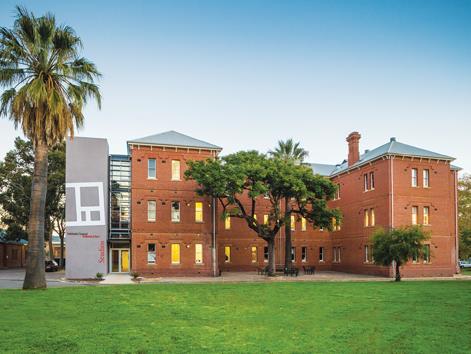Image courtesy Adelaide Central School of Art.
Adelaide Central School of Art has occupied its heritage home in the Glenside Cultural Precinct for less than three years, and as Project Manager Luke Thurgate explained, the move has allowed the School to flourish.
‘There’s a condensed creative energy that pervades the School,’ he said, ‘Especially because our Level Three and Four students have on-site studios … This concentration of creative output, extends their learning experience by fostering a supportive and dynamic collegiate environment.’
A diverse group of around 200 students are enrolled at the School, all undertaking the Bachelor of Visual Art (BVA) and BVA Honours programs.
The average student-to-lecturer ratio is 10-1, and small class sizes are not the only thing that differentiates the School’s program from larger institutions.
‘Another thing that separates us is a focus on laying a foundation of sophisticated making skills. Drawing, for instance, is compulsory all the way through the degree. It provides a framework for building confidence, testing ideas, experimenting with process and thinking critically about studio practice,’ Thurgate said.
Unlike a lot of other visual art degrees, students don’t specialise in one discipline in their final year, instead using this skills grounding to develop coherent bodies of work. Many final year students do not limit themselves to traditional mediums, instead favouring an inter-disciplinary approach to their studio practice.
‘It’s all informed by a really solid understanding of making, and an ability to draw links between research and practice. The curriculum builds a sound base in the early years, equipping students with the technical knowledge to explore a broad range of studio outcomes. As the degree continues students are also challenged to place their practice within a wider context of contemporary, professional practice.’
Daytime, evening and part-time study options make it possible to fit study around your life. ‘The beauty of being a single-focus art school is we can work one-on-one to develop study plans that cater for students’ external commitments. This flexibility and ongoing support is vital for our students, ensuring they get the most out of their degree,’ Thurgate said.
Public programs delivered by lecturers from the degree program provide a taste of the School. Thurgate enthused that the four short courses each year are ‘an ideal entry point for the degree. Often students come and do a short course, fall in love with the place, and decide they want to enrol in the degree program.’
‘Our students graduate ready to go. Their talent, creativity and passion for art has been nurtured through the degree and they leave equipped with the skills and knowledge to pursue a whole range of successes.’ Why not check out the School’s Open Day on 16 August and consider joining them?
For more information, visit www.acsa.sa.edu.au.





